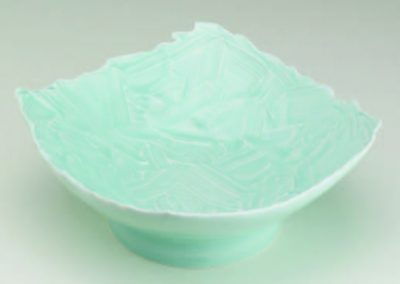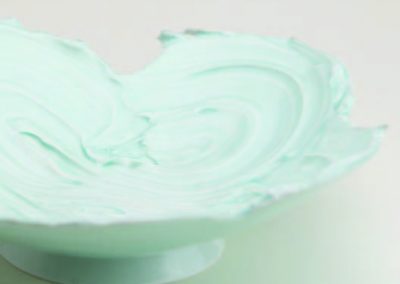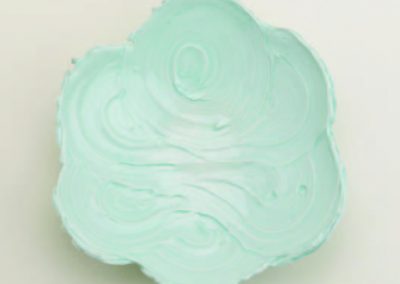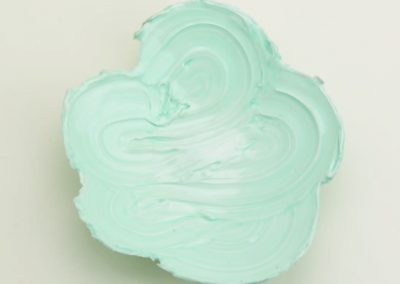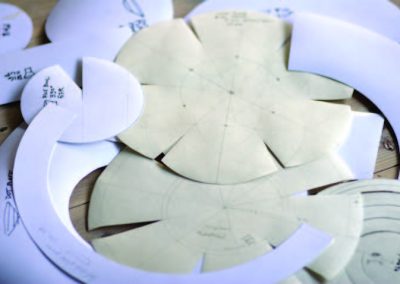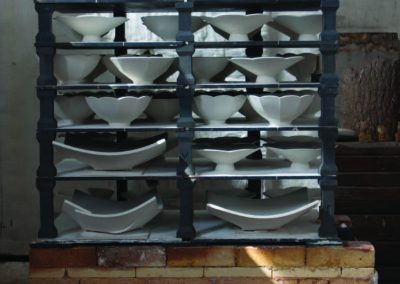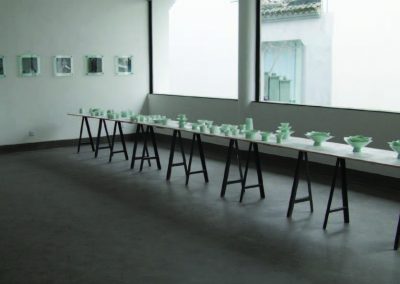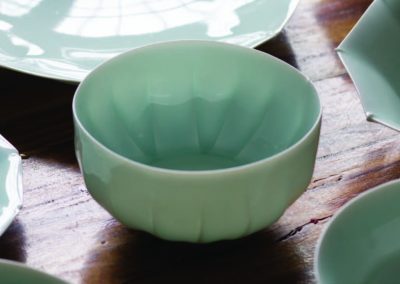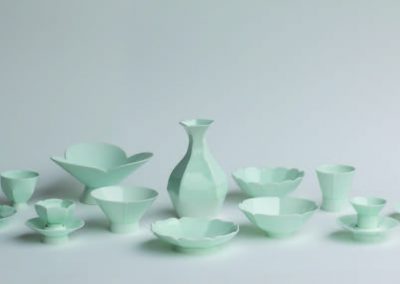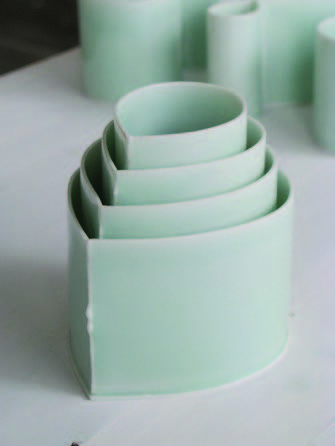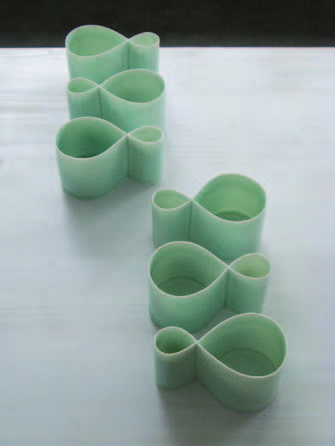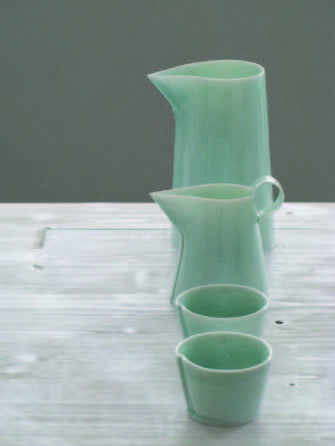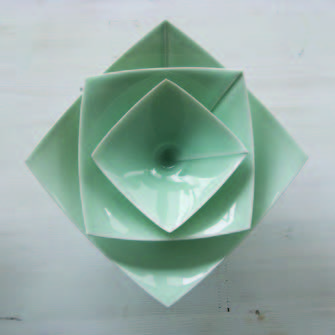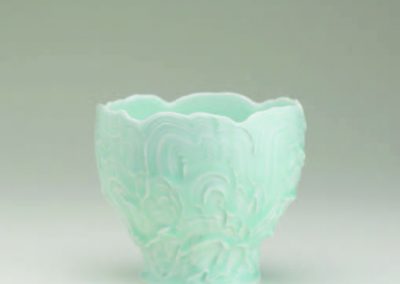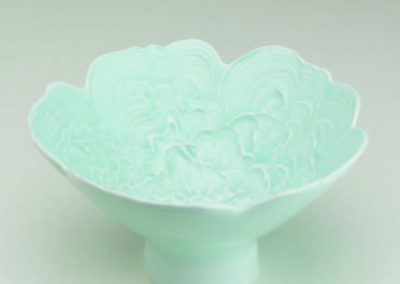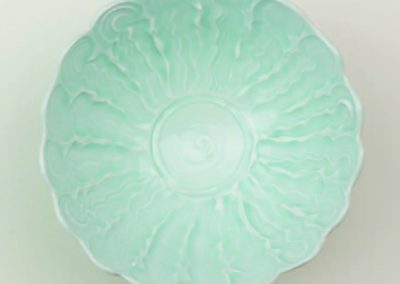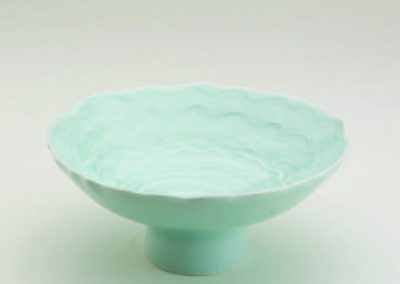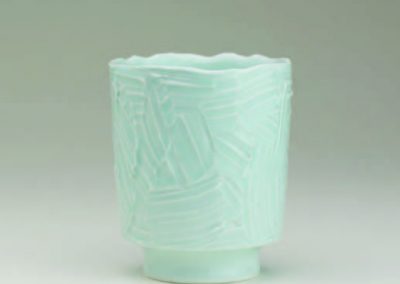We have recently added the Glazy online ceramic glaze database to our new website. Glazy has been developed by an American “geek-potter” Derek Philip Au. Derek worked in the IT industry in the US and is committed to open source software and free sharing of knowledge using the internet. Here is Derek’s story, and it is an interesting one.
My life has followed a circuitous, meandering path and I do not have the usual qualifications of a ceramic artist. Although pottery has been a very important part of my life since I took my first pottery course in college, it was only many years later after coming to Jingdezhen that I dedicated myself fully to ceramics.
I was born in 1975 and grew up in Florida. I studied ceramics and art at my first college, then dropped out and moved to California in order to “become a potter”. Things didn’t work out, and I went back to university and studied a variety of subjects while still regularly throwing pots.
Then came the first internet bubble. I became fascinated with programming and switched majors to Computer Science.
After a few years in the IT industry I burned out, quit my job and spent a few months just making pots.
As money dried up I decided to look for employment in the non-profit sector, and in 2000 I began working for an environmental group in Amsterdam. While in Europe I became more involved in environmental activism, and that work led me to various Asian countries. In 2004 I finally landed in Hong Kong, and Beijing shortly thereafter.
I fell in love with the culture and decided to enroll full-time in Mandarin courses.
After living in Beijing for a time, I was once again short on money. Offered a job in New York, I was packing my bags until a friend convinced me to give my old dream of becoming a potter a shot.
I arrived in Jingdezhen in 2007 as a resident artist at The Pottery Workshop. After one month, Takeshi Yasuda (then the director) offered me a job as one of the resident studio managers.
After two years at The Pottery Workshop, I wanted more time for my own studio practice so I left and established my own small studio.
During this time I was working on a series of slab-constructed porcelain vessels that I called Planeware. In 2011 I moved into a larger studio and began researching firing, glazes and traditional Chinese materials more seriously.
Becoming a ceramicist in China
In China, craft techniques and recipes are traditionally handed down within a family or group from generation to generation, so artisans in China are in general not as open and sharing as Western potters.
Glaze recipes in particular are closely guarded secrets, and artisans have even been known to intentionally spread false knowledge in order to protect their domain.
Furthermore, since ancient times Chinese ceramics has followed a style of assembly-line production in which each master artisan is only responsible for one step of the production process.
This tradition has carried on into the present day: Most ceramicists in Jingdezhen are not “potters” in the Western sense, instead they usually only specialize in one technique (like painting) or they design ceramics that are in turn produced by local artisans.
These two facets of Chinese craft culture, secrecy and specialization, make it quite diffcult for an outsider to learn directly from local artisans. Instead I’ve relied heavily on books and the internet for information.
John Britt’s High Fire Glazes was my first introduction to glaze making, while Nigel Woods’ Chinese Glazes has been my constant companion.
Whenever I’ve had technical questions I’ve searched Google or the Clayart mailing list archives at http://potters.org. Luckily, there are a lot of potters in the world generously sharing their knowledge online.
As I found more and more ceramic recipes from the internet it became increasingly diffcult to organize them in my messy computer spreadsheets.
Finally, in 2015 I decided to take a few months off from my studio work and create Glazy.
The concept of a glaze database is not new.
Various desktop glaze calculation programs have been available in the past, but most of these programs were discontinued when the sole developer retired or lost interest.
Glaze recipes and databases are now available on a number of websites. Some are simply text exports from old programs like GlazeChem while others, like https://insight-live.com and https://ceramicrecipes.org are fully searchable with chemical analyses and photos.
However, Glazy is unique in its emphasis on archiving and sharing.
Archiving recipes
Ceramics recipes are often published on the internet without any context. It’s common to come across recipes without references to the original author, publication, or even a photo of the intended result.
Furthermore, recipes change over time. Names and descriptions are modified, materials are substituted or modified to suit local materials.
As potters rely more upon social media sites like Pinterest and Facebook, it becomes increasingly important to have a trustworthy archive of recipes that can serve as a reference. To this aim, I spent a lot of time searching for and importing old glaze recipes that I found on the internet.
The Glazy database was originally seeded with data from Linda Arbuckle’s GlazeChem database, John Sankey’s glaze database, and Louis Katz’s Hyperglaze database.
Apart from archiving recipes, Glazy promotes sharing.
As with open-source software development, we can improve as ceramicists if we share our recipes, working together to improve them. I’ve often heard that ceramics recipes “don’t travel well”- in fact some grumpy potters insist that recipes are useless!
However, if we test often and discuss our results, we can gradually improve our recipes.
Unlike the master glaze makers in Jingdezhen, we don’t have entire lifetimes to devote to making the “perfect” glaze, but by working as a team we can come closer.
Open-source development
In addition to sharing recipes, another goal of Glazy is to share glaze software. There are a surprising amount of “geek” potters in the world with specialities in a number of fields, from Chemistry to Computer Science.
Since its release in 2015, the Glazy website has improved considerably due to feedback from a number of ceramicists all over the world.
In particular, Matt Katz of Alfred University (http://www.alfredceramics.com/katz.html) provided invaluable insights regarding the Stull Chart and UMF.
This year I plan on releasing a new version of Glazy that will have multiple improvements. Once the new version is tested and released, the Glazy website will be open-sourced so that anyone can run their own Glazy web server and contribute to improving the code.
I hope that by open-sourcing Glazy, the ceramics community will overcome the “single developer” problem that plagued glaze calculation software in the past, i.e. reliance upon a single person to continually update and maintain a piece of software.
How you can contribute to Glazy
For the time being, regardless of whether you are “geeky” or “artsy”, you can already contribute to the Glazy community by simply adding your own recipes and glaze photos. You can also help us by firing tests of old recipes that do not have photos.
Even if the tests aren’t pretty, they still contain valuable information and will be helpful to others. Finally, you can join the Facebook Group Ceramic Recipes in which we discuss glaze-making, firing, and recipes on Glazy.
Currently, Glazy has a very poor materials database and interface. The next version will be better, including personalized lists of materials only in your studio, as well as geographic lists for materials in specific locales like Australia.
For the time being, if you have a list of Australian materials you can send them to me and I will be sure to include them.
About Derek’s Work
Derek Au is a ceramicist based in Jingdezhen, China. In 2007, Derek began developing a style of porcelain slab construction in part inspired by tinware techniques. The result, Planeware, has similarities with tinware, origami, and Song Dynasty qingbai ware (which, in turn, was influenced by Tang Dynasty silver and gold ware). (http://www.derekau.net/)
After his last Planeware exhibition in 2012, Derek decided to go back to the basics, researching traditional Chinese ceramic materials and techniques, while also collecting and studying antique Chinese ceramics. As a result of this research, in 2015 Derek built an open-source ceramic recipes website, Glazy (http://glazy.org).
In 2016 Derek began working on a new series, Painted, in which slips are applied with brushes. While the technique is related to Japanese hakeme, Painted is concerned with the history of decorative slips and carving in ancient Chinese ceramics, as well as the history of Chinese ceramics as the subject of Western painting.
Exhibitions
2008/09 Solo Exhibition
Pottery Workshop C2 Gallery. Jingdezhen, China.
2009/05 Form & Function: Ceramics Group Exhibition
Two Cities Gallery. Shanghai, China.
2009/07 Ningbo Contemporary Ceramics Exhibition
Ningbo Museum of Art. Ningbo, China.
2009/07 Foundation: Summer Show
Two Cities Gallery. Shanghai, China.
2009/12 Wang Hao & Derek Au Functional Ceramics Exhibition
Pottery Workshop C2 Gallery. Jingdezhen, China.
2010/02 Group Exhibition
Light Square Gallery, Adelaide College of the Arts. Adelaide, Australia.
2010/05 First International Triennale of Kogei in Kanazawa, “Network Crafting”
21st Century Museum of Contemporary Art. Kanazawa, Japan.
2010/06 Spring Auction 2010-Contemporary Design
Hosane Auction House. Shanghai, China.
2010/08 Varied Life Exhibition “参差日常”生活展
微山行 Design Gallery. Shanghai, China.
2011/01 Foundation: Functional
Two Cities Gallery. Shanghai, China.
2011/04 2nd Dimension Contemporary Ceramics Group Exhibition
Ningbo Contemporary Art Museum. Ningbo, China.
2011/06 Transcending Time
BMW Hap Seng Star Gallery. Kuala Lumpur, Malaysia.
2011/12 Tooling
National Tainan University of the Arts. Tainan, Taiwan.
2012/04 Teaware: 5 Person Exhibition
Moganshan Road M50 Art Industry Park. Shanghai, China.
2012/06 Documentary《china 瓷》
CCTV-9 Documentary. Beijing & Jingdezhen, China.
2012/08 Solo Exhibition
The Clay Studio. Philadelphia, USA.
2015/08 Glazy Open Source ceramics recipes library
http://glazy.org
2016/08 Utilitarian Clay VII National Symposium Invited Artists Exhibition
Arrowmont School of Arts & Crafts. Gatlinburg, Tennessee.
2016/09 Designed & Crafted 16
Signature Gallery, Atlanta Contemporary. Atlanta, Georgia.



